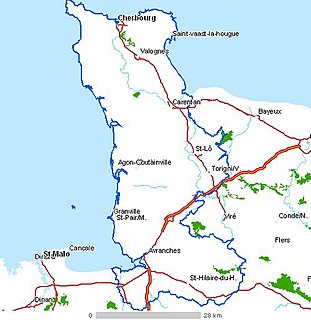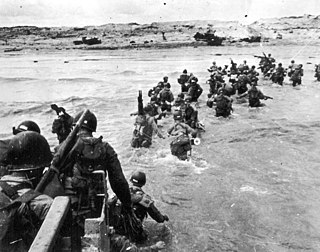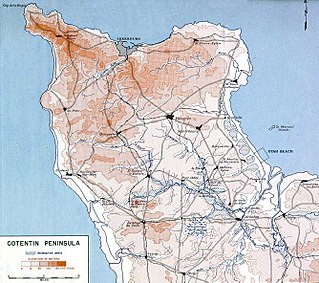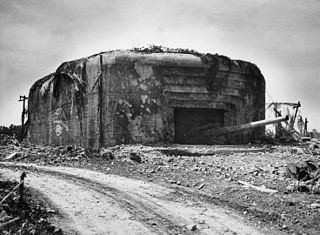Related Research Articles

Omaha, commonly known as Omaha Beach, was the code name for one of the five sectors of the Allied invasion of German-occupied France in the Normandy landings on June 6, 1944, during World War II. "Omaha" refers to an 8-kilometer (5 mi) section of the coast of Normandy, France, facing the English Channel, from east of Sainte-Honorine-des-Pertes to west of Vierville-sur-Mer on the right bank of the Douve River estuary. Landings here were necessary to link the British landings to the east at Gold with the American landing to the west at Utah, thus providing a continuous lodgement on the Normandy coast of the Bay of the Seine. Taking Omaha was to be the responsibility of United States Army troops, with sea transport, mine sweeping, and a naval bombardment force provided predominantly by the United States Navy and Coast Guard, with contributions from the British, Canadian, and Free French navies.

The Cotentin Peninsula, also known as the Cherbourg Peninsula, is a peninsula in Normandy that forms part of the northwest coast of France. It extends north-westward into the English Channel, towards Great Britain. To its west lie the Channel Islands and to the southwest lies the peninsula of Brittany.

Utah, commonly known as Utah Beach, was the code name for one of the five sectors of the Allied invasion of German-occupied France in the Normandy landings on June 6, 1944 (D-Day), during World War II. The westernmost of the five code-named landing beaches in Normandy, Utah is on the Cotentin Peninsula, west of the mouths of the Douve and Vire rivers. Amphibious landings at Utah were undertaken by United States Army troops, with sea transport, mine sweeping, and a naval bombardment force provided by the United States Navy and Coast Guard as well as elements from the British, Dutch and other Allied navies.

Gold, commonly known as Gold Beach, was the code name for one of the five areas of the Allied invasion of German-occupied France in the Normandy landings on 6 June 1944, during the Second World War. Gold, the central of the five areas, was located between Port-en-Bessin on the west and La Rivière on the east. High cliffs at the western end of the zone meant that the landings took place on the flat section between Le Hamel and La Rivière, in the sectors code-named Jig and King. Taking Gold was to be the responsibility of the British Army, with sea transport, mine sweeping, and a naval bombardment force provided by the Royal Navy as well as elements from the Dutch, Polish and other Allied navies.

La Pointe du Hoc is a promontory with a 100-foot (30 m) cliff overlooking the English Channel on the northwestern coast of Normandy in the Calvados department, France.

Sainte-Mère-Église is a commune in the northwestern French department of Manche, in Normandy. On 1 January 2016, the former communes of Beuzeville-au-Plain, Chef-du-Pont, Écoquenéauville and Foucarville were merged into Sainte-Mère-Église. On 1 January 2019, the former communes of Carquebut and Ravenoville were merged into Sainte-Mère-Église.

The Regional District of Central Okanagan (RDCO) is a regional district in the Canadian province of British Columbia, comprising the City of Kelowna, City of West Kelowna and their surrounding municipalities. The regional district's offices are located in Kelowna.

Pimpirev Beach is the portion of the northwest coast of South Bay, Livingston Island, Antarctica bounded to the southwest by Ereby Point and to the northeast by the north corner of the bay marked by an ice sea cave located 5.8 km east-northeast of Ereby Point and 1.45 km northwest of Aleko Point.

The Battle of Cherbourg was part of the Battle of Normandy during World War II. It was fought immediately after the successful Allied landings on 6 June 1944. Allied troops, mainly American, isolated and captured the fortified port, which was considered vital to the campaign in Western Europe, in a hard-fought, month-long campaign.

Sainte-Marie-du-Mont is a commune in the Manche department and in the region of Normandy in north-western France. The commune has 740 inhabitants.
Beauséjour was a village in France that was largely destroyed in World War I. It was part of the commune of Minaucourt-le-Mesnil-lès-Hurlus (Marne).

The Baie de la Seine or Baie de Seine is a bay in northern France.

Osborn Landing is an unincorporated community in New Kent County, Virginia, United States.

Əliqulu is a village in the Lachin Rayon of Azerbaijan.

The Crisbecq Battery was a German World War II artillery battery constructed by the Todt Organization near the French village of Saint-Marcouf in the department of Manche in the north-east of Cotentin peninsula in Normandy. It formed a part of Nazi Germany's Atlantic Wall coastal fortifications. The main armament were three Czech 21 cm Kanone 39 canons, two of which housed in heavily fortified casemates up to 10 feet thick of concrete. The battery, with a range of 27–33 kilometers, could cover the beaches between Saint-Vaast-la-Hougue and Pointe du Hoc.

Moss Landing State Beach is a state park on Monterey Bay, in Monterey County, California.

The siege of Tripoli occurred in 1551 when the Ottomans besieged and vanquished the Knights of Malta in the fortress of Tripoli, modern Libya. The Spanish had established a fort in Tripoli in 1510, and Charles V remitted it to the Knights in 1530. The siege culminated in a six-day bombardment and the surrender of the city on 15 August.

Moss Landing Wildlife Area is a California State wildlife preserve on the shore of Elkhorn Slough.

La Cachucha beach is a beach located in Puerto Real, Spain. It's 500 meters long with golden and fin-grain sand. Nowadays the beach needs periodics sand nourishments because natural conditions were modified. The beach is protected from the waves by two dikes. Every day when the tide is low, there is a large extension of mud where you can see many crabs and protected birds that feed on the seaside.